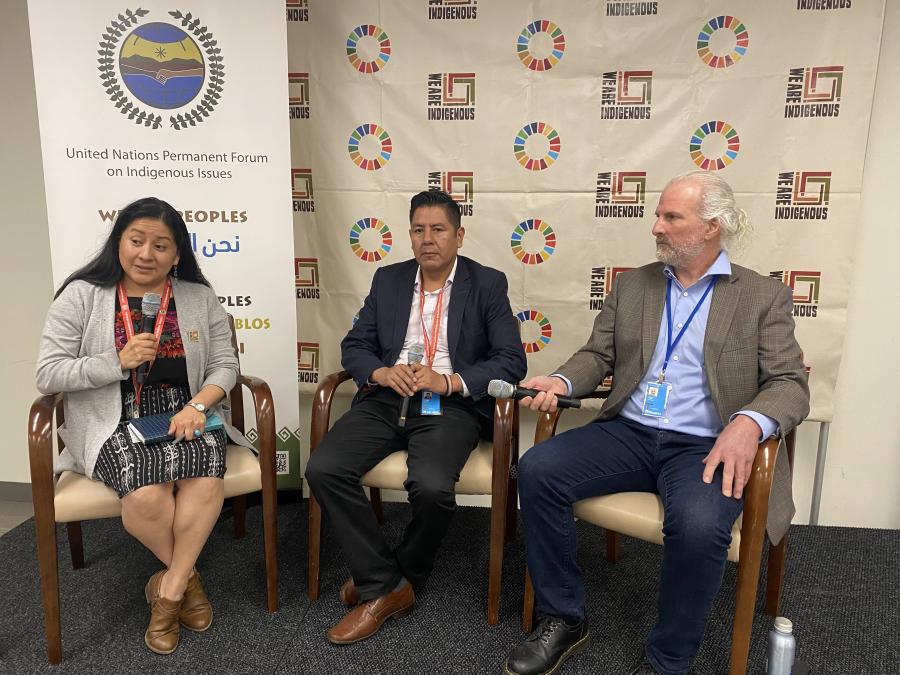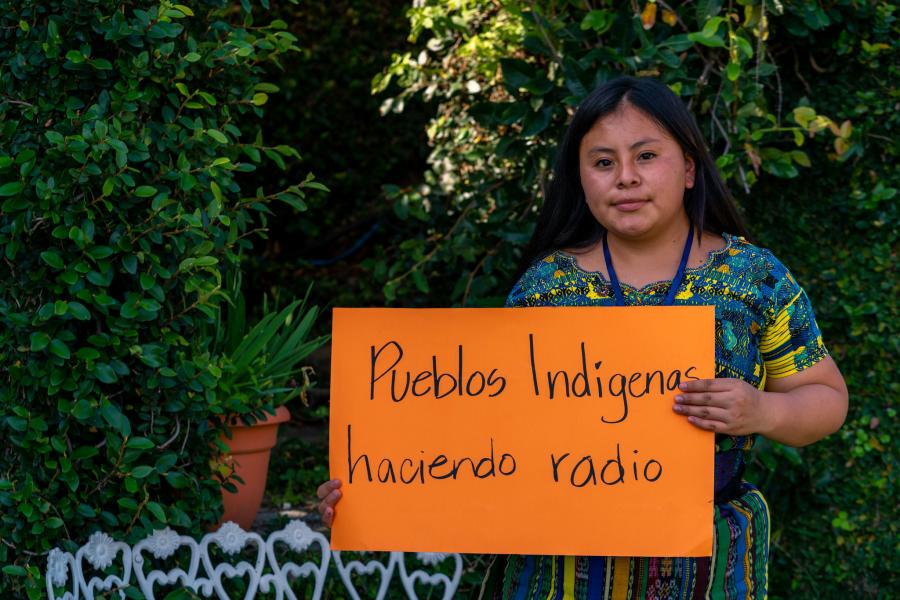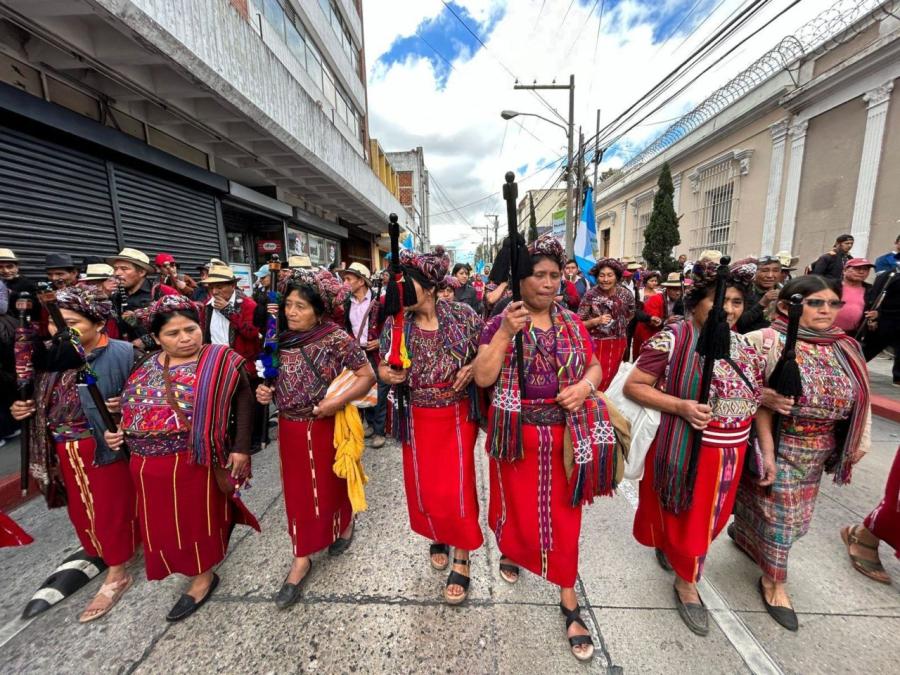Today, in probably the most systematic form since the Spanish conquest, the culture and traditions of Guatemala's highland Mayan Indians are under attack. The military regimes that have ruled Guatemala since its brief democratic "spring" ended in 1954 previously took little interest in the country's indigenous groups, which make up about 60 percent of the population.
However, since 1978 - when Indians in overwhelming numbers began to join popular organizations such as the Committee for Campesino Unity (CUC) and the various guerrilla organizations that make up the Guatemalan National Revolutionary Unity (UNRG) - the army has focused its attention and its counterinsurgency effort on the highlands, about 90 percent Indian.
The Military's Counterinsurgency Plan
From 1980 to 1981, the situation in the highlands was one of "nearly total war," according to an army spokesman interviewed in Guatemala City. When whole villages organized to defend their lands and to demand their basic rights, military government initiated the first stage of a counterinsurgency plan, the main architect of which was Gen. Benedicto Lucas Garcia, brother of then-President Gen. Romeo Lucas Garcia.
This first stage, which the military referred to as the pacification stage, came into full swing under the Rios Montt regime. It called for the massacre and destruction of villages considered supportive of the guerrillas and for the formation of local civil defense patrols, of which membership was obligatory.
In 1983, the pacification stage of the plan supposedly completed, the military moved into stage two of its counterinsurgency plan. The main thrust of this stage is the reorganization of the social and cultural life of those areas most affected by the war - in other words, the primarily Indian highland region.
That the army considers the problem an ethnic or racial one as well as one of national security is clear from an article published in an army magazine, the Revista Militar. The article, based on an army intelligence study carried out in 1981, discusses what is to be done about the Ixil people. The Ixil Indians were one of the first indigenous groups to organize themselves; since 1980, the main towns of what is known as the Ixil triangle in northern Quiche, have been practically under siege. A solution the Revista Militar article suggested was the ladinoization of the Ixil population in such a way that it ceases to exist as a cultural subgroup.
What is meant by ladinoization is that they become Spanish speakers, that their distinctive clothing and all other external features that differentiate them as a group be suppressed. Without these differentiating characteristics they will cease to think of themselves as such (Ixiles) and accept the abstract concepts of nationality and homeland.
The main aspects of this second stage of the military's counterinsurgency plan, according to army documents, include strengthening and expanding the civil patrols, developing the Food for Work program and creating "development polls" in the conflict areas. More recently, institutional coordinators were established to give the military control over state and parastatal development agencies.
Extremely sophisticated, the counterinsurgency plan aims to control the civil population and to destroy the culture and traditions of an ethnic majority in such a way that they continue to exist only in a form that is beneficial to, and manageable by, the status quo.
Civil Patrols Destroy Time-honored Traditions
The military government's plan borrows heavily such foreign counterinsurgency methods as US and British experience in the building of strategic hamlets and new villages in Vietnam and Malaysia, and South African experience in creating new townships and controlling a racial majority.
The civil patrols, the lynchpin in the government's counterinsurgency plan, are also a foreign concept. Colonel D'jalma Dominguez, ex-head of army intelligence, claims that their closest predecessor is the German "lansvoer" - soldiers without an army - formed during the Franco-Prussian war.
Ostensibly civil defense units, the civil patrols in Guatemala comprise about 900,000 members. Membership in the patrols is compulsory in the sense that nonparticipation labels one a subversive, which in Guatemala means almost certain death.
Every village in Guatemala, no matter how small, has a patrol post at the entrance, and every able-bodied man must report for duty. Usually they carry out two 24-hour shifts a week, depending on the size of the community.
Each unit is usually made up of about 20 men armed with weapons from horse whips to old M-1 rifles. Their leaders are often ex-soldiers and they take their orders from the local military commander. With such weapons, the defense capacity is limited, but their psychological role is important.
As one army colonel explained, "Before, he (the Indian) was Juan Pedro from a certain village (or ethnic group). Now, in the civil patrol, he feels part of Guatemala. Every civil patrol post has its little Guatemalan flag, whether it's of paper, plastic or whatever, and he is beginning to identify with it."
An extremely effective control system, the patrols must account for every able-bodied man in the community at all hours of the day and night and for all movement in and out of the community.
The army uses civil patrols to do some of its dirty work - at the same time dividing communities - by forcing patrol members to assassinate and torture members of their own villages. Patrol members have little alternative but to comply or be shot for disobeying the local military commander's orders.
By replacing the traditions of self-government and communal maintenance of order with military and paramilitary groups, the army is rapidly destroying time-honored Indian customs. Community elders and elected leaders are no longer able to play their traditional leadership roles.
In an attempt to usurp traditional Indian customs, the army organizes civil patrol rallies on what were once Mayan feast days. Members are "forced" to wear traditional costumes previously only worn to perform certain rituals. In addition they are taught to clap and throw their hats in the air and other non-Indian types of behavior. Indian women are forced to take part in beauty contests for such titles as Miss Civil Patrol or Miss Military Zone, wearing their Indian costumes.
It must be understood that while it may appear - as the army claims - that Indians take part willingly in these events, military control is so pervasive in Guatemala that even to show reluctance to participate in these activities would be exceedingly dangerous. However, Guatemalan Indians interviewed in Mexico have expressed outrage at army interference in their customs and particularly the degradation Indian women suffer by having to take part in what to them are such "foreign" customs.
The economic effect of the patrols on these communities is similarly severe. Previously most families supplemented their incomes by working on the large coffee and cotton plantations. Patrol duty now restricts the amount of time they can spend away from their villages. Only the local military commander may excuse individuals from patrol duty. In some villages, where the army mistrusts the inhabitants, this has meant that the men can't leave at all.
As a result, in many communities the number of women who have had to abandon their traditional crafts, such as weaving and pottery, in order to supplement the family income by taking jobs as servants in nearby towns has increased.
The Food for Work Program
Life in the highlands has been so affected by the war that planting and harvesting cycles have been severely disrupted. Many areas have not had a harvest in two years.
The government is trying to force the Indians to change their ancient lifestyles by ending the cult of maize. Maize has always played an important role in Mayan culture, but today, according to an army intelligence expert, the government intends to import corn from the United States and encourage Indians to grow vegetables such as onions or asparagus for export.
Another factor disrupting the harvest cycle is the location of the milpas (cornfields) which are situated above the Indians' villages on the mountainsides. Nowadays, special permission is needed to work them because the army believes that people may try to make contact with the guerrillas or give them food or medicines.
Included in the military government's counterinsurgency plan, however, is the Food for Work program, the most recent successor of a range of unsuccessful attempts to eliminate hunger in the highlands. Its predecessors include the Roofs and Jobs and Beans and Bullets programs. It is, however, more ambitious in its objectives and aims to modify the Indians' eating habits by introducing new food items into their daily diet.
An army document defines the program as "part of the concept of security and development and [it] is to provide a broad workforce at the disposal of reconstruction and construction programs." People are put to work building roads and bridges and are paid with rations of food rather than wages.
Once incorporated into the program, it is very difficult to leave. Receiving payment in kind means that it is practically impossible to save cash in order to travel to look for other kinds of work. The Food for Work program fits neatly into the military government's plan to control the population and saves it money it would otherwise have to spend on wages to construction workers.
Development Polls a Political Sham
The most ambitious part of the counterinsurgency plan, however, is the resettlement program, which focuses once again on the highland region. The resettlement areas are referred to by the military as "development polls" and the four main ones are in the Ixil triangle in Quiche, Chisec in Alta Verapaz, Playa Grande in Quiche, and Chacaj in northern Huehuetenango.
Their specific objectives differ according to their location. Chacaj, near the border with Mexico, was specifically designed to resettle refugees currently in Mexico, while Playa Grande is for those still fighting with, or sympathetic to, the guerrillas in Ixcan and the refugees in the Marquis de Comillas in the south of Mexico. Chisec is to accommodate the internal refugees in Alta Verapaz. Acul, Tzalbal and others in the Ixil triangle are to resettle the displaced and attract the population still resisting in the surrounding areas.
The settlements may differ in their objectives, but they share the common purpose of consolidating army control over the indigenous population and creating an infrastructure from which to launch military raids and offensives. So far, all have been constructed in the front line of the military's fight with the guerrilla organization, the EGP (Guerrilla Army of the Poor).
There are various types of settlements. Some, such as Acul and Tzalbal in the Ixil triangle', are model strategic villages that are shown off to visiting journalists, diplomats and aid agency workers. There are many more reconstructed, redesigned "new villages" with fewer services such as Las Pacayas in Alta Verapaz. Often these are villages that were previously destroyed by the army and where massacres took place. Other settlements, where the focus is control, are little more than refugee camps with practically no services. Many of these are in Baja Verapaz.
Finally, and so far unique, is the Acamal "reeducation" center, where the approximately 1,500 exclusively Indian inmates - supposedly former active guerrilla supporters - are being held under strict military control.
At least another 40 new villages are projected for the near future. So far nearly all of the new settlements have been inaugurated with a great deal of publicity - often by President General Mejia Victores or other leading army officials accompanied by a retinue of journalists and photographers. The army is depicted as the benefactor, providing new housing and extensive facilities for the poor Indians who have sought its protection and escaped the clutches of the guerrillas.
While this is the official propaganda, most other observers, such as church people and community leaders, described the slave-like existence in the model villages, the coercion of the inhabitants, the excessive monitoring of their movements and the breaking down of the traditional Indian lifestyle. According to a report published by members of the British Parliamentary Human Rights Group, who visited Guatemala in October 1984, people in the settlements are "subjected to rigorous work schedules, followed by compulsory drill and then patrolling at night; to compulsory political education and serious food shortages."
All the new settlements are constructed to army designs and are organized in such a way as to facilitate control. Houses are built in straight rows with little space between them, often clustered around or with easy access to a main road. This is in contrast to traditional Indian villages which are usually far from a main road with the houses spread out.
The negative effects of this forced concentration are evident in the increase in alcoholism, child neglect and wifebeating in these communities. According to a religious worker in Baja Verapaz, rape - previously practically unknown in Indian communities - often occurs in the new settlements.
In the department of Alta Verapaz, one of the largest development polls, where land problems have always been the main source of discontent, recent abuses of Indian land rights have occurred in the Northern Transversal Strip project in which Indian lands were appropriated and given to military officers. The Indian lands were appropriated in order to curtail problems among certain sectors of the military who felt they were not getting as big a slice of the cake as they believed is due the upper echelons of the Guatemalan army.
An explicit government policy of mixing ethnic language groups in the new villages forces people to learn Spanish. Because little land is available for cultivation in the new settlements, potatoes and other vegetables are grown instead of corn. Most of the settlements are not self-sufficient and depend on international aid. According to an article in the Meso-America newsletter, one of the purposes of the new villages is "to disrupt the traditional Mayan corn-earth-man relationship."
While evangelical groups have easy access to the settlements, the army does not encourage the Catholic church to take an active part in the life of these new villages. The church, a basic feature in the central plaza of most villages in Guatemala, is missing from the new settlements.
Many Indians who were active in the popular organizations were catechists who had been deeply influenced by the theology of liberation. The work of these church people in the strongly Catholic rural communities was a key factor in awakening the indigenous population to the root causes of their oppression.
While Indians are being forced to abandon many of their ancient customs, local authorities are encouraging residents of the settlements to keep wearing their traditional costumes to promote tourism. To the casual visitor, life in the new settlements may seem normal enough. But the people in one such settlement described their lives as "empty and listless."
Community life is extremely important to the indigenous peoples of Guatemala, but the new settlements are nothing more than a militant colonel's drawing-board dream - complete militarization of the countryside with primary objectives to control, exploit, intimidate and undermine the local Indian communities. The Guatemalan generals may now speak optimistically of Guatemala's "new way of life." But it remains to be seen whether a people who have managed to defend their traditions over centuries will now submit to such "pacification" without resistance.
Update
In a recent visit to Guatemala, in February 1986, members of the government and military would provide no definite answer as to whether the development polls program would continue under the new civilian government. But, it was clearly indicated that there would be no substantial changes in the program. In fact, new villages continue to be constructed and President Cerezo himself inaugurated the most recent in the Chiset development polls on February 14.
While reportedly the institutional coordinators are to be civilians in the future, it is widely accepted that the army will maintain its control of the program as a whole. The newly created Ministry of Urban and Rural Development, headed by Dr. Rene de Leon Schlotter, is now the body responsible for coordinating all development projects in Guatemala, including development polls. The new minister has expressed his appreciation of the army's initiative in this area and has indicated that only minor modifications if any would take place in the program.
With regard to the civil patrol, while some local residents claim the patrols have been disbanded in their area, such as in Panajachel (a largely tourist area), as the previous frequent checking and stopping of traffic appear to have abated. General Jaime Hernandez, the new defense minister, has said that the Civil Patrols Project will continue in force at least in the short term.
Article copyright Cultural Survival, Inc.



